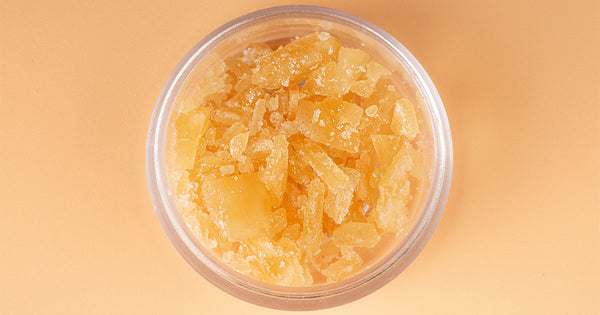How to Maximize Cannabis Yield: A Guide to a More Profitable Filtration
Feb 17, 2023

The cannabis industry is booming, and with the increasing demand for high-quality products, the need for efficient extraction and filtration methods has never been greater. Cannabis filtration requires a high-quality input to get a high-quality end product. Maximizing yields in extraction and filtration is crucial for both quality and profitability, as the more concentrated and lighter-colored the product and the greater its value.
What Is Cannabis Processing Yield?
The cannabis processing yield refers to the amount of usable product produced from a given amount of starting material. It's a critical metric that affects the profitability of the extraction and filtration process and is a key factor in determining the overall efficiency of the operation.
The yield of an extraction and filtration process depends on several factors, including the quality of the starting material, the extraction method used, the filter media used, and the conditions of the extraction process. Higher-quality starting material, optimized processing conditions, and advanced techniques will result in a higher yield.
To calculate the yield of an extraction or filtration process, volume-wise, the weight of the final product is divided by the weight of the starting material. This yield is typically expressed as a percentage, and it can range depending on the product quality.
In the cannabis industry, yield is an important consideration when choosing a processing method. Different processing methods have different yields, so choose the method that provides the best return on investment while still producing a high-quality product.
Why Cannabis Processing Yields Matter
Cannabis extraction is a complex and time-consuming process, and every step must be executed correctly to ensure a high-quality final product. However, even with the best practices in place, extractors can still lose out on yield due to various factors, such as improper equipment operation, poor-quality input material, and inefficient extraction techniques.
Losing out on yield has significant financial implications for extractors, directly impacting their bottom line. With each milligram of product lost, extractors lose valuable revenue and potentially harm their reputation with customers who expect a consistent and high-quality product.
Moreover, a decrease in yield can also result in a decline in overall product quality, as the final product may contain more impurities, have a lower potency, or have an off-taste or odor. This can lead to customer dissatisfaction and a decline in repeat business, further damaging the extractor's reputation and financial stability.
A decline in yield can also lead to increased costs, as extractors may need to invest in additional raw materials, equipment, and labor to make up for the loss. This can strain their finances and create a vicious cycle of increased costs and decreased profits.
Extractors should take into account all aspects of the operation, from seed to oil, including the cultivation process, choice of filter media, the use of the right equipment, and the implementation of best practices for cleaning and maintenance.
They must also regularly assess and adjust the filtration process to identify areas for improvement and make any necessary changes to ensure optimal performance. By taking a strategic and methodical approach to cannabis filtration, extractors can maximize their yield.
Understanding the Cannabis Plant Material

The quality of your plant material is critical to the success of the filtration process. High-quality plant material is characterized by a high concentration of trichomes, the structures that contain valuable cannabinoids and terpenes.
The quality of plant material can be affected by various factors, including genetics, growing conditions, and harvest timing. Therefore, it's essential to choose a strain that is known to produce a high concentration of trichomes and to ensure the plants are grown and harvested under optimal conditions.
Genetics
The genetic makeup of the cannabis plant has a direct impact on the quality and composition of the final product. Different strains of cannabis have different concentrations of THC, CBD, and other active ingredients, so choose the right strain for the desired end product.
Growing Conditions
The plant’s growing environment, such as temperature, light intensity, and water, can have a significant impact on the plant’s vegetative growth and the final quality of the plant material. When growing cannabis, cannabis plants grown at high temperatures may have a lower concentration of active ingredients, while those grown in ideal conditions may have a higher concentration.
During the vegetative stage, the plant focuses more on growing leaves and stems to provide a robust structure for the developing buds during the flowering stage. Outdoor and indoor growers face unique challenges in maintaining an ideal environment for their flowering plants.
Plant Training
Plant training is an essential aspect of cannabis cultivation that can have a significant impact on the cannabis processing yield. Properly trained plants can result in a higher yield of high-quality material, while untrained plants may produce lower-quality material and lower yield.
One of the critical factors in plant training is understanding the early flowering stage of the plant, as this is when viable bud sites start to form. During this stage, promote even plant growth and enhance bud growth by adequately training the plant.
There are several plant training techniques that can be employed to achieve this goal, including topping, super-cropping, low-stress training (LST), and high-stress training (HST).
Topping involves removing the growing tip of the plant to promote branching and create a more bushy structure, leading to the formation of more viable bud sites. Super-cropping involves gently bending the branches to increase their exposure to light and promote growth, enhancing bud development.
LST involves tying down the branches to promote lateral growth, allowing for more even growth and the formation of more buds. HST involves more aggressive techniques, such as bending or cutting the branches to promote growth and enhance bud development.
Harvest Time
The harvest timing also affects the quality and composition of the plant material. Harvesting the plant too early or too late in the flowering stage can result in lower cannabis yields and lower-quality extracts.
Drying and Curing
Proper post-harvest processing of the plant material, such as drying and curing, can also affect the final yield and quality of the extracted product. Improper processing can result in degraded material, which can negatively impact the yield and quality of the final product.
Freezing
Fresh-freezing cannabis is a game-changer in the world of cannabis extraction. This method involves immediately freezing the freshly harvested plant material rather than allowing it to dry, which can degrade the quality and potency of the valuable compounds.
Freezing cannabis buds help to preserve the potency and quality of the active ingredients, resulting in higher yields and a higher-quality final product. This method is becoming increasingly popular as more and more producers look to maximize the yield and quality of their extracts.
One of the crucial benefits of freezing is that it allows the producer to start the extraction process immediately after harvest rather than waiting for the plant material to dry. This not only results in higher yields and a higher-quality product, but it also speeds up the overall production process.
Another advantage of freezing is that it eliminates the need for drying and curing, which can be time-consuming and result in the degradation of cannabinoids and terpenes. This makes fresh-freezing an efficient and cost-effective solution for producers looking to maximize the yield and quality of their extracts.
Extraction Techniques
There are two main types of extraction techniques: solvent-based and solventless. Solvent-based extraction uses chemicals like ethanol or CO2 to separate the active compounds from the plant material, while solventless extraction uses physical means such as heat and pressure. Each technique has its advantages and disadvantages, and the right technique will depend on specific needs and resources.
Mechanical Separation
Mechanical separation uses physical force, such as grinding or sifting, to separate the active ingredients from the plant material. This method is simple and inexpensive, but it is also less efficient and results in a lower yield than other methods.
Rosin Pressing
The rosin technique involves using heat and pressure to extract the active ingredients from the plant material. This method is known for its simplicity, efficiency, and high-quality final product.
Ice Water Extraction
Ice water extraction involves using freezing temperatures and agitation to extract the trichomes from the plant material. Ice water extraction produces a high-quality final product and has a gentle approach, but it is also a slower and more labor-intensive process compared to other solventless methods.
CO2 Extraction
Carbon dioxide (CO2) extraction uses supercritical carbon dioxide as the solvent. CO2 extraction is efficient, high yielding, and produces a high-quality end product. However, it is also a more complex and expensive method compared to other solvent-based techniques, and it requires specialized equipment.
BHO Extraction
BHO, or butane hash oil extraction, is a method that uses butane or propane as the solvent. BHO is one of the most efficient and high-yielding methods, but it also requires safety precautions to protect from workplace hazards and processing to remove residual solvent in the end product.
Ethanol Extraction
Ethanol extraction uses ethanol as the solvent. Ethanol extraction produces a high-quality extract, but it is also less efficient, removes unwanted chlorophyll, and may result in a lower yield than other solvent-based techniques.
Equipment and Process Optimization

The right equipment and a well-optimized process are essential for maximizing yield in extraction. Proper temperature control, pressure management, and time management are all critical to the success of the extraction process. Consider factors such as the composition of the plant material, the type of extraction technique used, and the desired end product when optimizing the process.
Extraction Equipment
Whether using CO2, BHO, ethanol, or a solventless method, having the right equipment for the job is crucial to a high yield. Consider factors such as efficiency, reliability, and safety when choosing equipment.
Process Parameters
The process parameters, such as temperature, pressure, and time, play a crucial role in the quality and yield of the extraction process. Carefully control these parameters to achieve the best results. For example, if using CO2 extraction, ensure that the right temperature, pressure, and time settings are used to achieve maximum efficiency and quality.
Quality Control
Implement a system for regularly testing and monitoring the quality of the extraction product, both during the extraction process and after it has been completed. This will help ensure that you are producing a high-quality final product that meets the standards of your customers.
Waste Management
Proper waste management is critical for maximizing efficiency and minimizing waste in your extraction operation. This includes managing and disposing of any solvents, spent plant material, and other waste products safely and responsibly.
Post-Extraction Processing

Winterization is a process that removes unwanted plant lipids and waxes from the extract. This is especially important for solvent-based extractions, as these unwanted materials can affect the clarity and stability of the final product.
Decarboxylation
Decarboxylation activates the THC and CBD in the extract, making them more bioavailable and effective for medicinal purposes. This process is typically done by heating the extract at a low temperature for a set period of time.
Filtration
Filtration is a critical step in the post-extraction processing stage. This process removes impurities and other unwanted materials from the extract, resulting in a purer, more stable final product. There are several different types of filtration media available, including activated carbon, activated bentonite clay, and more, each with its specific advantages and disadvantages.
Distillation
Distillation separates the active ingredients in the extract into their individual components, allowing for the creation of more targeted and potent products. This process is typically done using specialized distillation equipment, requiring a high degree of skill and experience to perform correctly.
Cannabis Extraction Technician

A skilled extraction technician understands the complexities of the extraction process and is equipped with the knowledge and expertise to optimize every step. From selecting the right strain to choosing the appropriate equipment, the extraction technician plays a vital role in ensuring a successful outcome.
The extraction technician must have a deep understanding of the various extraction techniques and the factors that influence the success of each method. They must also be familiar with the equipment and processes and have the technical know-how to troubleshoot any issues. A good extraction technician will have a thorough understanding of post-extraction processing and the steps required to produce a high-quality, valuable product.
In addition to their technical expertise, the extraction technician must also have strong organizational skills. The extraction process is complex and requires close attention to detail, and a skilled technician must be able to manage multiple tasks simultaneously while maintaining a keen focus on the quality of the final product.
Finally, the extraction technician must be safety-conscious and adhere to all safety protocols. Extraction can be dangerous, and it's essential to follow strict safety procedures to avoid accidents and protect the technician and the equipment.
Automation in Cannabis Processing
Automation is transforming many industries, and cannabis extraction is no exception. Automation has the potential to revolutionize the extraction process, increasing efficiency, reducing costs, and improving the quality of the final product.
One of the biggest advantages of automation in cannabis processing is the ability to standardize processes. Automated systems can ensure that each extraction is performed consistently, reducing the risk of human error and providing more reliable and consistent results. This is especially important for large-scale operations where manual extraction may be too time-consuming and prone to inconsistencies.
Automated systems also offer greater control over the extraction process, allowing technicians to fine-tune the parameters and optimize the yield. With automated systems, extraction technicians can adjust temperature, pressure, and other critical parameters in real time, leading to a more efficient and effective extraction and filtration process.
In addition to improving efficiency, automation offers more safety than manual extraction. Automated systems are designed with safety in mind, and they often come equipped with sensors and alarms that can alert technicians to potential hazards and shut down the system in the event of an emergency.
Automation can also help to reduce costs in the long run. Automated systems are often more efficient than manual methods, and they can also reduce the risk of wasted materials, spills, and other losses.
Color Remediation

Color remediation is a filtration process that ensures the quality and appeal of cannabis extractions. The right type of filter media can make all the difference in removing impurities and improving the appearance of the extract.
Activated Charcoal
Activated carbon is a highly porous material widely used in color remediation due to its ability to effectively remove impurities that cause the extract to darken. Activated carbon can be made from various materials, including coconut shells, bamboo, and peat.
Silica Gel
Silica gel is a porous material that can remove impurities, resulting in a clearer and more stable final product. Silica gel can also be used to absorb moisture, which can further improve the stability and quality of the extract.
Activated Bleaching Clay
Activated bleaching clay is a type of filter media commonly used in color remediation due to its ability to lighten the color of the extract. This clay is often used to remove chlorophyll and other impurities that can cause the extract to darken.
Diatomaceous Earth
Diatomaceous earth is made from the fossilized remains of single-celled algae. It is widely used in color remediation due to its ability to remove unwanted compounds and improve the clarity and color of the extract.
Activated Bentonite Clay
Activated bentonite clay is a type of filter media commonly used in color remediation to lighten the color of the extract. This type of clay has a neutral pH level and does not end up in the end product.
Activated Magnesium Silicate
Activated magnesium silicate can remove pesticides and pigments, as well as fats and lipids. However, it may be more costly than other filter media.
Activated Alumina
Activated alumina can remove red and yellow pigments due to its porous and spherical form. The filter media can be reused again after heating for a certain amount of time.
Degumming Enzyme
Degumming enzymes is a filter media used to remove gums, triglycerides, and lipids from the extract. Extractors may need to adjust the pH and temperature for best results.
Tips for Maximizing Performance with Cannabis Filter Media
Choosing the Right Color Remediation Column
Color remediation columns are designed to remove unwanted color and impurities from the extracted oil, resulting in a clearer and more visually appealing product. Usually made of stainless steel, these are designed to withstand the rigorous conditions of the cannabis filtration process.
In the cannabis filtration process, every component plays a crucial role in the overall performance and success of the process. From the primary components such as filter media and CRCs, to additional pieces of equipment such as gaskets, sintered disks, needle valves, flow controllers, and high-pressure clamps, each component works together to ensure that the process runs smoothly, efficiently, and safely.
Proper selection, maintenance, and use of all components in the filtration system is essential to maximizing performance.
Maintain Proper Flow Rates During Filtering
Maintaining proper flow rates during the extraction filtration process is crucial for better filtration. If the flow rate is too high, the filter media may become clogged, reducing its efficiency. If the flow rate is too low, it can result in longer processing times and increased costs. Monitor the flow rate and adjust as necessary or use automated processes to streamline operations.
Avoid Clogging of Filter Media
Clogging of the filter media can be a major issue during the extraction process. Clogging occurs when particles become trapped in the pores of the filter media. Avoid clogging by choosing appropriate filter media, loading the proper ratio of filter media, and monitoring the flow rate during filtration.
Clean Equipment and Replace Filter Media Regularly
Regular cleaning and replacement of the filter media equipment is essential. Over time, the filter media components may become contaminated with impurities. Follow the manufacturer's instructions for maintenance and replace the filter media at regular intervals.
Store Filter Media Properly
Proper storage of the filter media is important for maintaining its performance over time. Exposure to moisture and other contaminants can reduce the efficiency of the filter media and shorten its lifespan. Keep filter media in a clean and dry place and avoid exposure to moisture.
Add the Finishing Touch with Media Bros
Once you've completed the extraction process, it's time to add the finishing touch. A critical step in the process is filtering the extracted product to remove any impurities, and Media Bros' filter media is the perfect solution to cannabis filtration.
Media Bros' filter media is designed to remove unwanted particles from the extracted product, leaving only the purest and most potent oil behind. Our filter media is available in various types and materials designed for BHO, ethanol, and CO2 extraction systems.
Our filter media and hardware is easy to use and can be quickly and easily installed into your existing filtration system. At Media Bros, we understand the importance of producing a high-quality extract, and we're dedicated to helping you achieve the best possible results.






